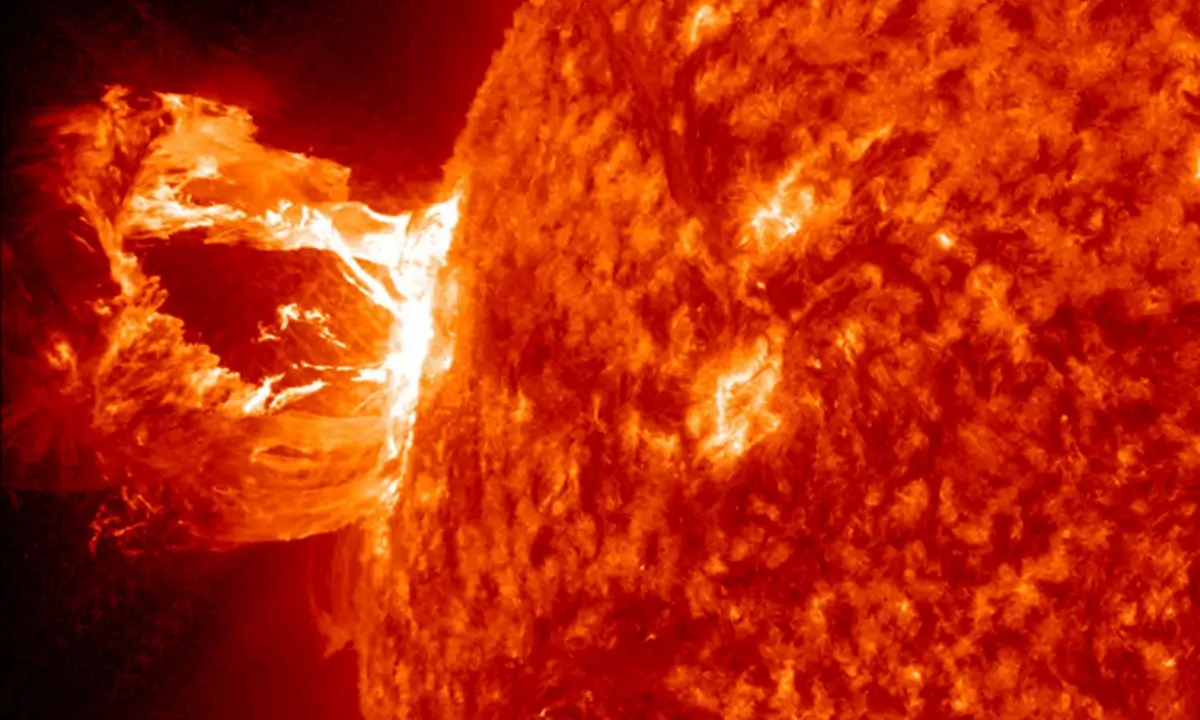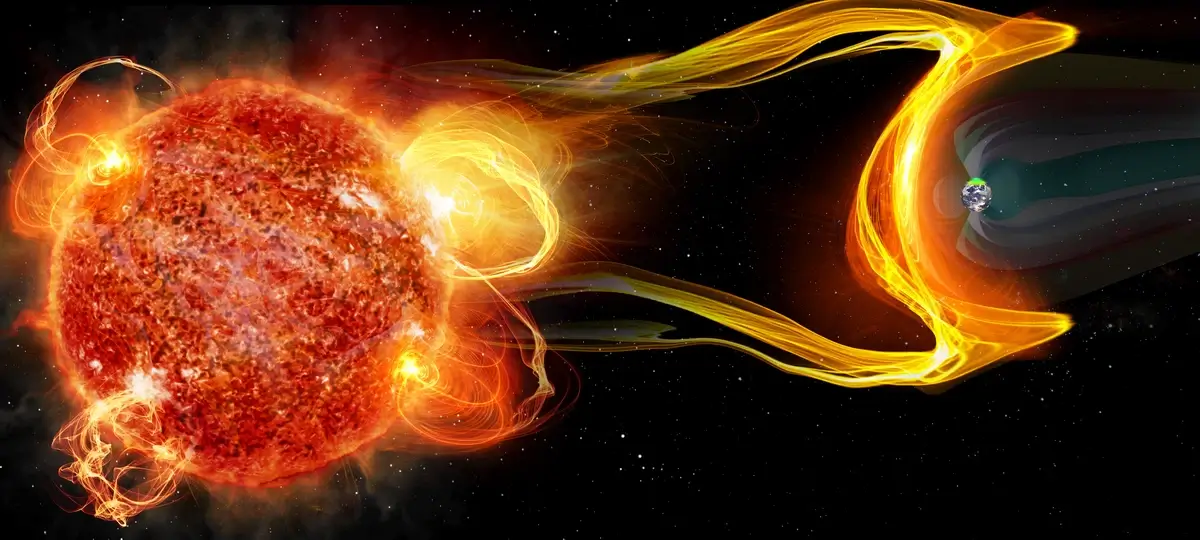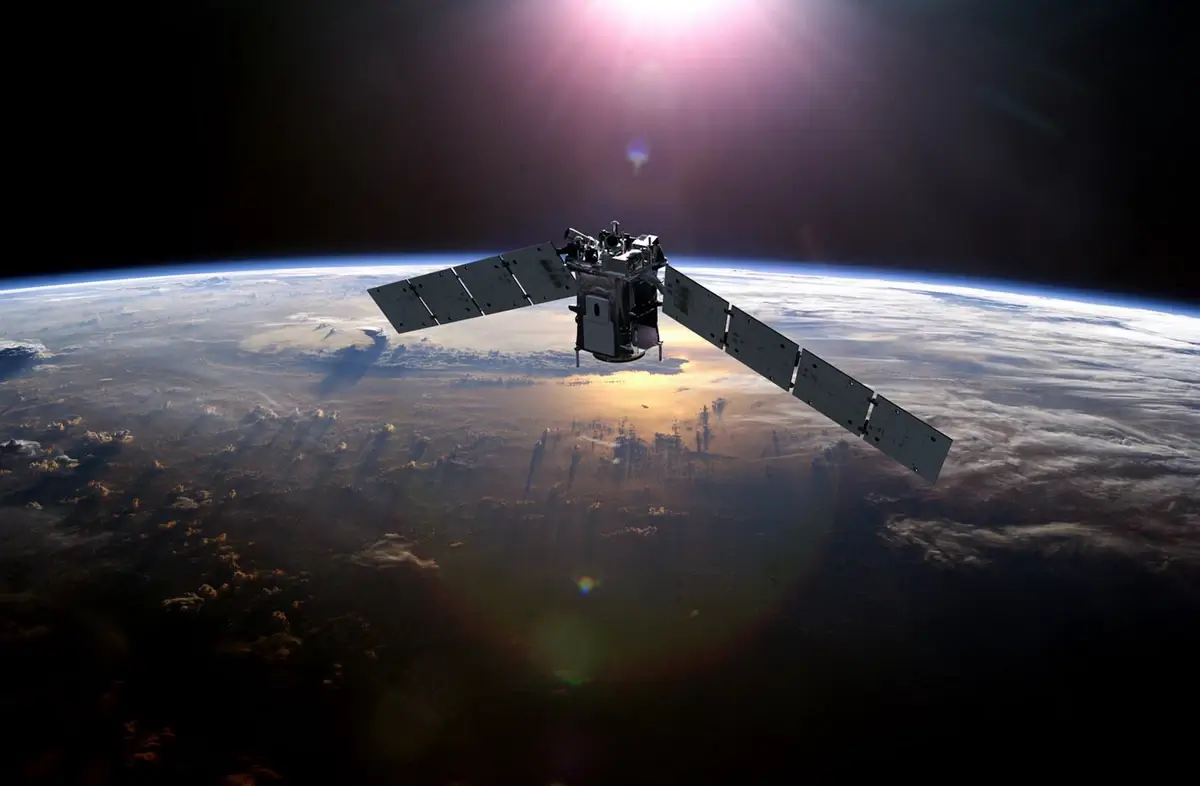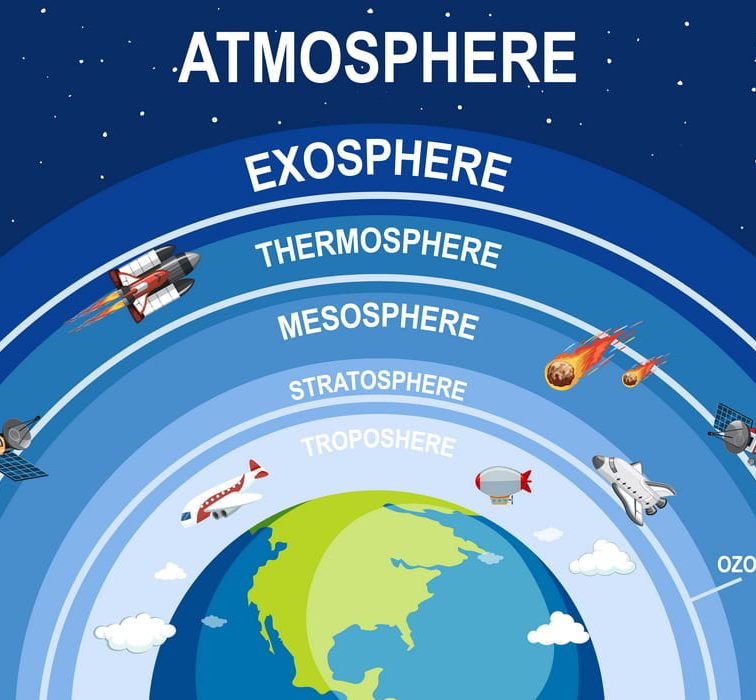The thermosphere, a layer between 80 and 600 kilometers above Earth, is a frontier of extremes. It was first identified in 1951 when scientists observed temperatures rising at higher altitudes. This layer, crucial in shielding Earth from harmful solar radiation, is a dynamic interface between our planet and space.
It’s where the air is too thin to breathe, yet thick enough to slow down satellites, a balance that shapes much of our modern satellite-based technology. Dive into our article for fun facts about the thermosphere, unveiling this layer’s fascinating secrets and impact on our world.
1. Exploring the Thermosphere: Earth’s Outermost Atmospheric Layer
The thermosphere is characterized by its low density and high temperature. It was first extensively explored during the International Geophysical Year (IGY) in 1957-58.
Temperatures here can reach up to 2,500°C, primarily due to the absorption of intense solar radiation. Despite these high temperatures, the thermosphere would feel cold to human skin because of the extremely low density of air molecules – a concept first understood through early satellite missions like Sputnik in 1957.

Image source: stylishbag.ru
2. Auroras: The Thermosphere’s Dazzling Light Show
Auroras, first scientifically described by Galileo in 1619, are predominantly visible in the thermosphere. These natural light displays are caused by solar winds interacting with Earth’s magnetosphere, funneling charged particles into the thermosphere.
The particles collide with gases like oxygen and nitrogen, creating the vivid colors of the Aurora borealis and Aurora australis. Peak auroral activity is closely linked to the 11-year solar cycle, with more frequent displays during periods of high solar activity.

Aurora borealis. Image: discover-the-world.com
3. The International Space Station (ISS): Orbiting in the Thermosphere
The International Space Station, orbiting within the thermosphere since its launch in 1998, offers an unparalleled platform for studying this layer. At approximately 408 km above Earth, the ISS experiences significant atmospheric drag, requiring regular boosts to maintain its orbit.
This unique position has allowed for extensive research into the thermosphere’s composition and behavior, particularly during periods of high solar activity, which can expand and alter this layer.

Image: observatornews.ro
4. Extreme Temperatures: The Thermosphere’s Wild Thermal Variations
The extreme temperature range in the thermosphere, first accurately measured by satellites in the 1960s, is a result of solar activity. During periods of high solar activity, ultraviolet and X-ray radiation increase, causing temperatures to rise dramatically. Conversely, during solar minima, temperatures can plummet.
This variability, which impacts satellite orbit decay and atmospheric drag, has been a crucial area of study for space agencies worldwide.
5. Satellites and Space Debris: The Thermosphere as a Cosmic Junkyard
The thermosphere is a critical zone for satellites, but it’s also cluttered with space debris. Since the launch of Sputnik in 1957, thousands of satellites have been sent into orbit, many of which now reside in the thermosphere.
This region has become increasingly congested, with about 128 million pieces of debris smaller than 1 cm, as reported by the European Space Agency in 2023. These fragments pose a significant risk to operational satellites and the International Space Station, leading to growing concerns about space sustainability and the need for effective debris mitigation strategies.

Space debris in the thermosphere. Image: universetoday.com
6. Radio Waves and the Thermosphere: How it Affects Communication
The thermosphere plays a vital role in radio communication. The discovery in the early 20th century that the ionosphere (part of the thermosphere) reflects radio waves revolutionized long-distance communication. This layer contains ionized particles that can bounce radio waves back to Earth, allowing them to travel beyond the horizon.
This phenomenon is crucial for radio broadcasts, aviation communication, and even affects GPS signals. However, solar activity can disrupt this layer, leading to communication blackouts, a challenge first noted during intense solar storms in the 1960s.
7. The Edge of Space: Defining the Boundary in the Thermosphere
The thermosphere is often referred to as the “edge of space.” The Kármán line, located within this layer at an altitude of 100 km, is internationally recognized as the boundary between Earth’s atmosphere and outer space.
This definition was proposed by Theodore von Kármán, a Hungarian-American engineer, in the 1950s. It’s significant for legal and regulatory reasons, particularly in determining the jurisdiction for spacecraft and satellites. This demarcation is also a benchmark for astronauts to officially earn their wings.
8. Solar Activity and Its Impact on the Thermosphere
Solar activity has a profound impact on the thermosphere. The 11-year solar cycle influences the density and composition of this layer. During periods of high solar activity, increased ultraviolet radiation heats and expands the thermosphere, impacting satellite orbits due to greater atmospheric drag.
This phenomenon was notably observed during the solar maximum in the late 20th century, which led to increased satellite orbital decay. Understanding this relationship is crucial for predicting satellite lifespan and planning space missions.
9. The Thermosphere’s Role in Earth’s Energy Balance
The thermosphere plays a critical role in Earth’s energy system. It absorbs a significant amount of solar radiation, particularly extreme ultraviolet (EUV) and X-rays, preventing these harmful rays from reaching the Earth’s surface. This absorption process generates heat, contributing to the high temperatures in the thermosphere.
The energy dynamics in this layer are complex, as they involve interactions with solar activity and other atmospheric layers. Studies, particularly since the early 2000s, have focused on how these interactions affect Earth’s climate and weather patterns.

Image: pinimg.com
10. Understanding the Ionosphere: A Sub-Layer of the Thermosphere
The ionosphere, a crucial sub-layer of the thermosphere, extends from about 60 km to 300 km above Earth. It was first identified in 1902 by Arthur E. Kennelly and Oliver Heaviside independently, who theorized its existence to explain how radio waves could travel long distances.
This layer is ionized by solar radiation, meaning it contains a high concentration of free electrons and ionized atoms. These charged particles are vital for radio communication, as they reflect and refract radio waves back to Earth.
The ionosphere’s variability, influenced by factors like solar activity and time of day, makes it a key area of study in understanding Earth’s upper atmosphere.
11. Space Weather: How the Thermosphere Influences It
Space weather, a concept that gained prominence in the 1950s with the advent of space exploration, is significantly affected by the thermosphere. This layer interacts with solar wind – streams of charged particles from the sun, which can cause geomagnetic storms and auroral activity. These interactions can impact satellite operations, GPS accuracy, and even power grids on Earth.
Understanding the thermosphere’s role in space weather is crucial for protecting technological infrastructure and for space exploration planning.

Visualization of solar wind interacting with Earth’s magnetic field and the thermosphere. Image: asu.edu
12. The Northern and Southern Lights: A Thermospheric Phenomenon
The Northern Lights (Aurora Borealis) and the Southern Lights (Aurora Australis) are stunning natural phenomena primarily visible in the thermosphere. These lights occur when solar wind particles collide with atmospheric gases, causing a spectacular display of color.
The first scientific description of the auroras was made by Galileo Galilei in 1619, though they have been observed by humans for thousands of years. The colors and patterns of the auroras are influenced by factors like the type of gas molecules involved and the altitude at which they collide, making each auroral display unique.

The Northern and Southern lights from space. Image: qz.com
13. Scientific Missions in the Thermosphere: Exploring the Unknown
Scientific missions in the thermosphere have been instrumental in expanding our understanding of this atmospheric layer. Since the 1950s, numerous satellites and probes have been launched to study the thermosphere’s composition, temperature, and interaction with solar radiation.
One notable mission is NASA’s TIMED (Thermosphere, Ionosphere, Mesosphere Energetics and Dynamics) satellite, launched in 2001, which has provided valuable data on how the thermosphere reacts to solar and magnetic influences. These missions are crucial for advancing our knowledge of Earth’s atmosphere and for developing technologies to navigate and utilize this unique environment.
14. The Mystery of Air Density in the Thermosphere
The air density in the thermosphere is a complex and intriguing aspect. At these altitudes, the atmosphere is extremely thin – density can be as low as a few particles per cubic centimeter. The first detailed measurements of this were made in the 1960s using satellites like Explorer 17.
What’s fascinating is how the density varies with solar activity. During periods of high solar activity, the thermosphere expands and becomes denser at higher altitudes, impacting satellite orbits. This variability poses unique challenges and opportunities for understanding atmospheric dynamics and satellite engineering.
15. The Hidden Influence of the Thermosphere on GPS Accuracy
The thermosphere has a lesser-known yet significant influence on GPS accuracy. Signals from GPS satellites travel through the ionosphere and thermosphere, where they can be delayed or refracted due to the charged particles in these layers.
This effect, first comprehensively studied in the late 20th century, is especially pronounced during periods of high solar activity, leading to GPS inaccuracies. Modern GPS systems account for these variations using complex algorithms, a testament to our growing understanding of the thermosphere’s impact on technology.
16. The Challenge of Measuring Temperatures in the Thermosphere
Measuring temperatures in the thermosphere presents significant challenges due to the layer’s thin air and high energy particles. Traditional thermometers cannot be used here; instead, temperatures are inferred from the behavior of gas molecules.
This was first successfully done using satellite data in the 1960s. The temperatures in the thermosphere can range from -90°C to over 2,500°C, influenced by factors like solar activity and time of day. Understanding these temperature dynamics is crucial for satellite design and predicting the behavior of Earth’s atmosphere.

Image: medium.com
17. Human Activities and the Thermosphere: Exploring the Connection
Human activities have a surprising connection to the thermosphere. The increasing number of satellites and space debris, mainly since the late 20th century, has made this layer an area of human impact. Additionally, certain radio frequencies used on Earth can affect the ionosphere, a sub-layer of the thermosphere.
Moreover, anthropogenic emissions can reach the lower thermosphere, potentially impacting its chemistry and dynamics. Understanding this connection is essential for sustainable space exploration and preserving the integrity of Earth’s upper atmosphere.
FAQ
What is a unique feature of the thermosphere?
A unique feature of the thermosphere is its extremely high temperatures, which can reach up to 2,500°C or higher. Despite these high temperatures, the thermosphere wouldn’t feel hot to a human because of its very low air density, meaning there are fewer molecules to transfer heat.
What are 2 things that happen in the thermosphere?
Two significant phenomena occurring in the thermosphere are the formation of auroras and the orbiting of satellites. Auroras, like the Northern and Southern Lights, are created by solar particles colliding with atmospheric gases, creating dazzling light displays. Additionally, the thermosphere is the layer where many satellites, including the International Space Station, orbit the Earth.
Why is the thermosphere important?
The thermosphere is important for several reasons. It helps to shield the Earth from harmful solar radiation, absorbing extreme ultraviolet and X-ray wavelengths. This layer is also crucial for radio communication, as it contains the ionosphere, where radio waves are reflected back to Earth. Additionally, its characteristics are vital for satellite trajectories and space exploration.
Who discovered the thermosphere?
The existence of the thermosphere was inferred from scientific studies in the early 20th century, but it was more definitively identified and understood through the use of satellites in the mid-20th century. The precise ‘discovery’ wasn’t attributed to a single individual but was rather a result of collective advancements in space science and technology.
What lives in the thermosphere?
No known life forms reside in the thermosphere due to its extreme conditions, including low air pressure, high radiation levels, and extreme temperatures. This layer of the atmosphere is inhospitable to life as we know it.
How thick is the thermosphere?
The thickness of the thermosphere varies but generally extends from about 80 kilometers (50 miles) to 600 kilometers (372 miles) above the Earth’s surface. This thickness can fluctuate based on solar activity, which can cause the thermosphere to expand and contract.
How hot is it in the thermosphere?
Temperatures in the thermosphere can range dramatically, typically between -90°C and 2,500°C (or more). The exact temperature can vary significantly based on solar activity, time of day, and altitude within the thermosphere.
How do satellites survive the thermosphere?
Satellites survive in the thermosphere by being designed to withstand extreme conditions, such as high temperatures and potential impacts from space debris. They are equipped with thermal protection systems to handle the significant temperature fluctuations. Additionally, satellite orbits are carefully calculated to account for factors like atmospheric drag and the thermosphere’s varying density.







